Complete Solutions to EXERCISES(TAKING IT TOGETHER) of chapter WORK, ENERGY AND POWER of Class 11 book with complete answers and questions
| Class 11 | PHYSICS |
| Chapter | WORK, ENERGY AND POWER |
| DC PANDEY NEET | EXERCISES(TAKING IT TOGETHER) |
| Number Of Questions | 83 |
| Academic Year | 2023-24 |
An electron and a proton are moving under the influence of mutual forces. In calculating the change in the kinetic energy of the system during motion, one ignores the magnetic force of one on another. This is because,
01:27View SolutionA man squatting on the ground gets straight up and stand. The force of reaction of ground on the man during the process is.
01:25View SolutionA body is falling freely under the action of gravity alone in vacuum. Which of the following quantities remain constant during the fall ?
03:55View SolutionA particle is moved from `(0, 0) to (a, a)` under a force `F =(x^(2)hati+y^(3)hatj)` from two paths. Path 1 si `OP` and Path 2 is `OQP`. Let `W_(1)` and `W_(2)` be the work done by this force in these two paths. Then
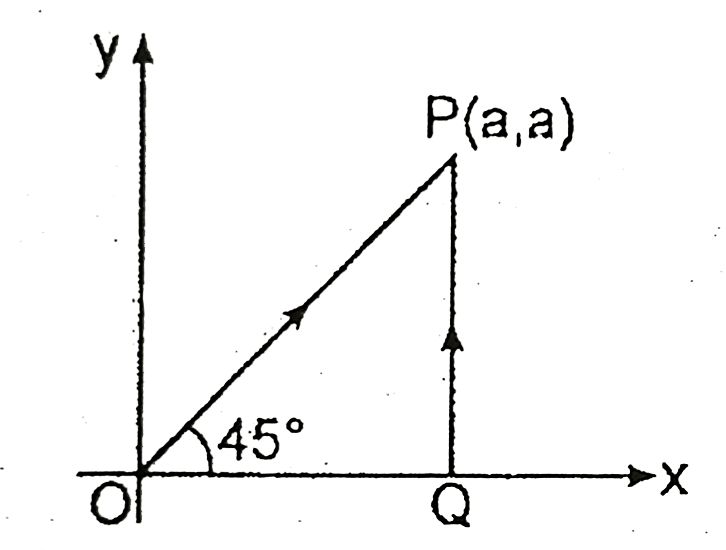 02:41View Solution
02:41View SolutionA body of mass m was slowly pulled up the hill by a force F which at each point was directed along the tangent of the trajectory. All surfaces aresmooth. Find the work performed by this force.
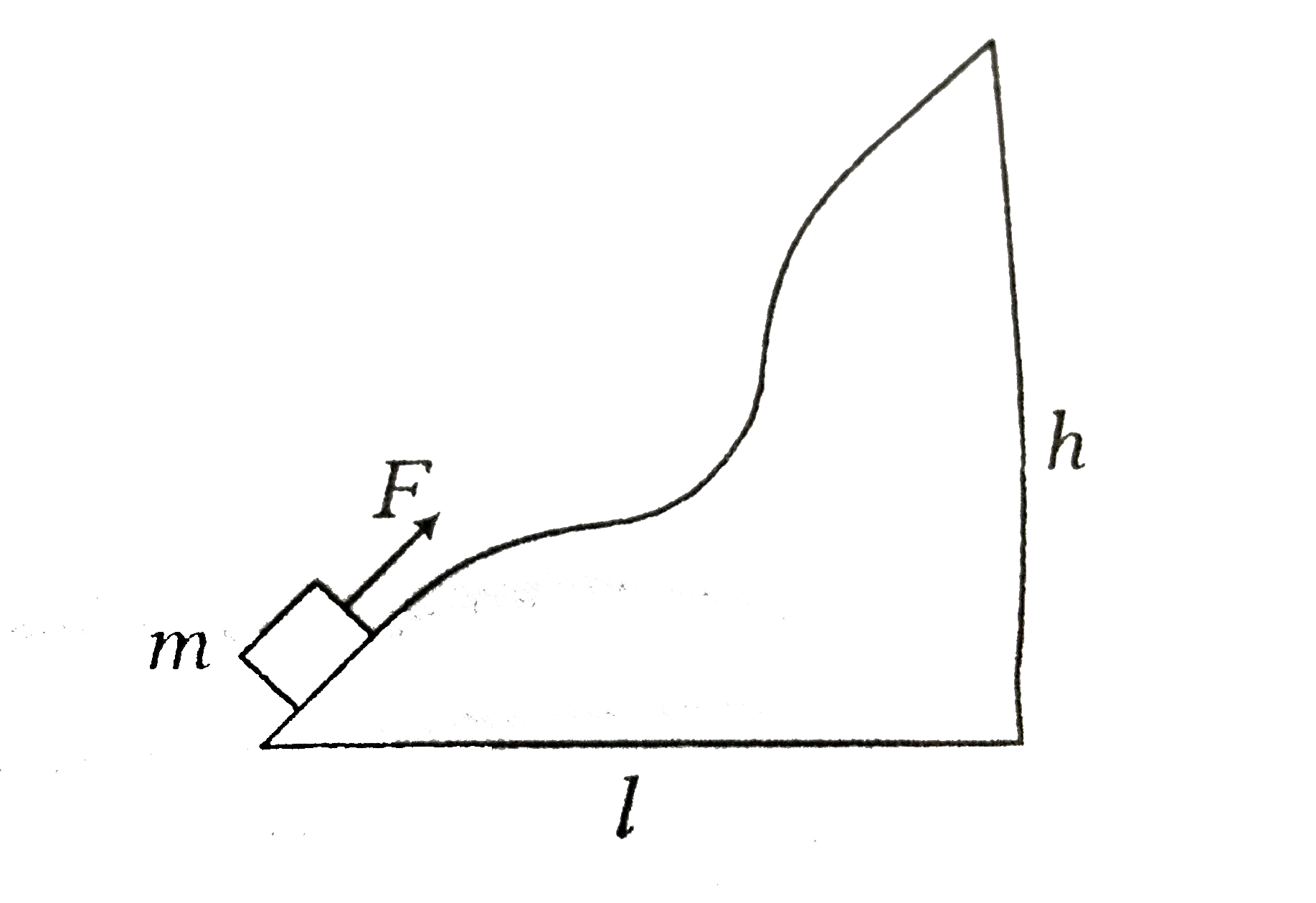 03:00View Solution
03:00View SolutionA rod of mass `m` and length `l` is lying on a horizontal table. Work done in making it stand on one end will be
03:12View SolutionThe pointer reading versus load graph for a spring balance is as shown in the figure.

The spring constant is01:29View SolutionThe momentum of a body is p and its kinetic energy is E. Its momentum becomes 2p. Its kinetic energy will be
02:21View SolutionIf v,p and E denote velocity, lenear momentum and KE of the paritcle respectively, then
01:23View SolutionTwo masses of 1 gm and 4 gm are moving with equal kinetic energies. The ratio of the magnitudes of their linear momenta is
01:30View SolutionWhen work done by force of gravity is negative, then
02:06View SolutionA bicyclist comes to a skidding stop in 10m. During this process, the force on the bicycle due to the road in 200N and is directly opposed to the motion. The work done by the cycle on the road is
02:20View SolutionA body is moving unidirectionally under the influence of a source of constant power supplying energy. Which of the diagrams shown in figure correctly shows the displacement-time curve for its motion?
05:54View SolutionWhich of the diagrams shown in figure most closely shows the variation in Kinetic energy of the earth as it moves once around the sun in its elliptical orbit?
07:59View SolutionWhich of the diagrams shown in figure represents variation of total mechanical energy of a pendulum oscillating in air as function of time?
01:39View SolutionA mass of `5kg` is moving along a circular path or radius `1m`. If the mass moves with 300 revolutions per minute, its kinetic energy would be
02:59View SolutionA particle moves from position `3hati+2hatj-6hatk` to `14hati+13hatj+9hatk` due to a force `vecF=(4hati+hatj+3hatk)`N. If the displacement is in centimeter then work done will be
03:37View SolutionA body moves from rest with a constant acceleration. Which one of the following graphs represents the variation of its kinetic energy K with the distance travelled x?
02:49View Solution`upsilon-t` graph of an object of mass 1 kg is shown. Select the wrong statement.
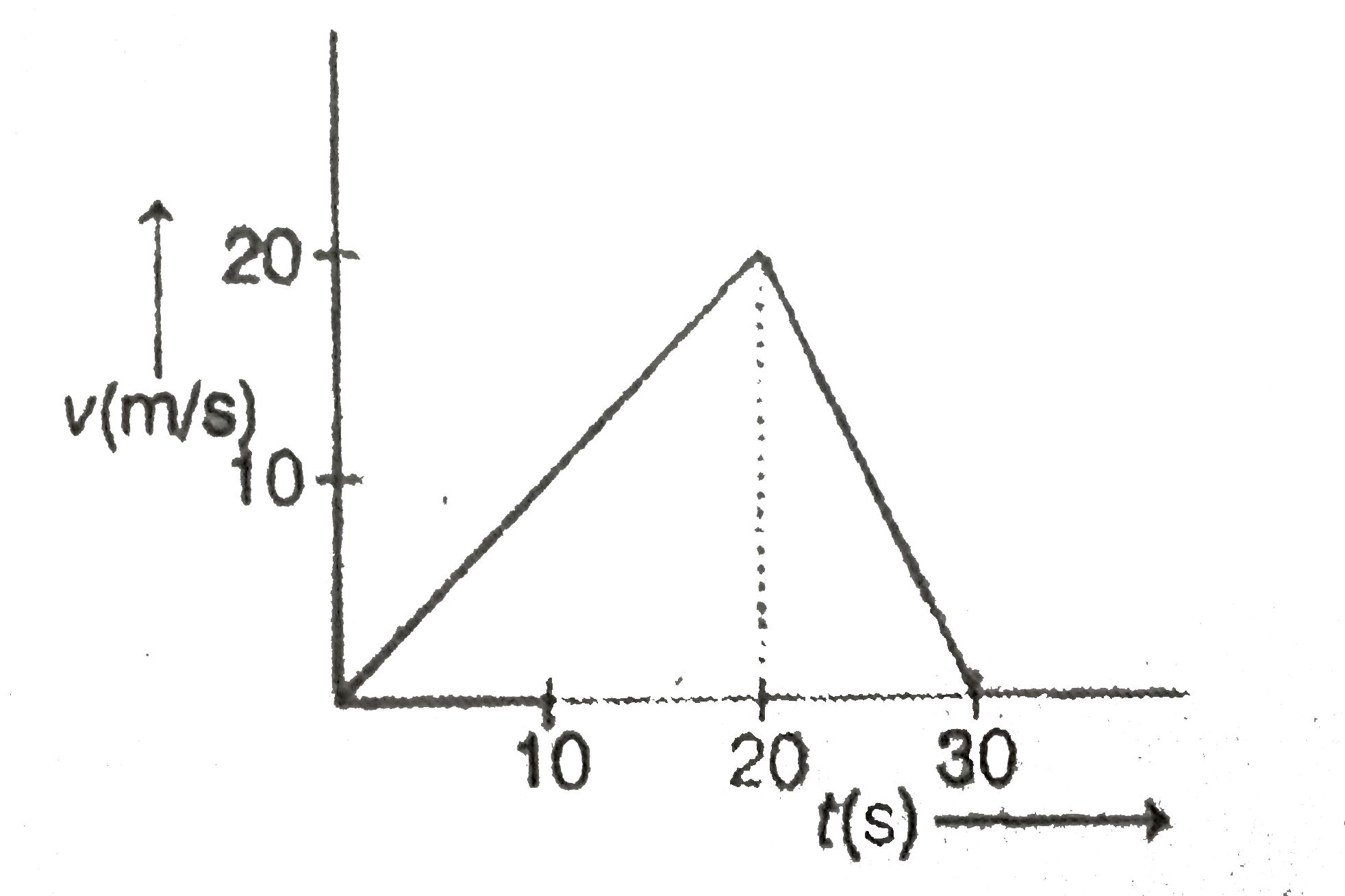 01:48View Solution
01:48View SolutionA toy gun a spring of force constant `k`. When changed before being triggered in the upward direction, the spring is compressed by a distance `x`. If the mass of the shot is `m`, on the being triggered it will go up to a height of
01:58View SolutionA car moving with a speed of `40 km//h` can be stopped by applying the brakes after at least 2 m. If the same car is moving with a speed of `80 km//h`, what is the minimum stopping distance?
02:52View SolutionA long elastic spring is stretched by `2 cm` and its potential energy is `U`. If the spring is stretched by `10 cm`, the `PE` will be
02:15View SolutionA body (initially at rest is falling under gravity. When it loses a gravitational potential energy by `U`, its speed is `v`. The mass of the body shall be `:`
01:15View SolutionIf a body of mass 200 g falls a height 200 m and its total P.E. is converted into K.E. at the point of contact of the body with earth surface. Then what is the decrease in P.E. of the body at the contact.
`(g=10m//s^(2))`02:42View SolutionA stone of mass 2 kg is projected upwards with KE of 98 J. The height at which the KE of the body becomes half its original value, is given by (take, `g=9.8ms^(-2)`)
02:15View SolutionMark out the correct statement(s).
01:35View SolutionA vehicle needs an engine of 7500 W to keep it moving with a constant velocity of 20 `ms^(-1)` on a horizontal surface. The force resisting the motion is
01:55View SolutionAn engine exerts a force `F=(20hati-3hatj+5hatk)` N and moves with velocity `v=(6hati+20hatj-3hatk) ms^(-1)`. The power of the engine (in watt) is
02:07View SolutionAn object of mass m, initially at rest under the action of a constant force F attains a velocity v in time t. Then, the average power supplied to mass is
03:17View SolutionA particle at rest on a frictionless table is acted upon by a horizontal force which is constant in magnitude and direction. A graph is plotted of the work done on the particle W, against the speed of the particle v. If there are no frictional forces acting on the particle, the graph will look like
02:21View SolutionThe energy required to accelerate a car from 10 m/s to 20 m / s is how many times the energy required to accelerate the car from rest to 10 m /s
04:06View SolutionA force `F= -khati+xhatj` where k is a positive constant, acts on a praricle moving in the xy plane. Starting from the origin, the particle is taken along the positive x - axis to the point (a,0) and then parallel to the y-axis to the point (a,a) the total work done by the formce on the particle is
03:46View SolutionGiven that the displacement of the body in meter is a function of time as follows
`x=2t^(4)+5`
The mass of the body is 2 kg. What is the increase in its kinetic energy one second after the start of motion?03:58View SolutionA block is attached to a spring as shown and very-very gradually lowered so that finally spring expands by 'd'. If same block is attached to spring and released suddenly then maximum expansion in spring will be
 04:06View Solution
04:06View SolutionA uniform chain of length L and mass M is lying on a smooth table and one third of its length is hanging vertically down over the edge of the table. If g is acceleration due to gravity, work required to pull the hanging part on to the table is
03:21View SolutionAn object of mass m is tied to a string of length L and a variable force F is applied on it which brings the string gradually at angle `theta` with the vertical. Find the work done by the force F.
 03:11View Solution
03:11View SolutionA particle is moving in a conservative force field from point A to point `B.U_(A)` and `U_(B)` are the potential energies of the particle at point A and B and `W_(C)` is the work done by conservative forces in the process of taking the particle from A and B, which of the following is true?
02:36View SolutionThree particles A, B and C are thrown from the top of a tower with the same speed. A is thrown straight up, B is thrown straight down and C is thrown horizontally. They hit the ground with speeds `v_(A), v_(B)` and `v_(C)` respectively:
04:21View Solution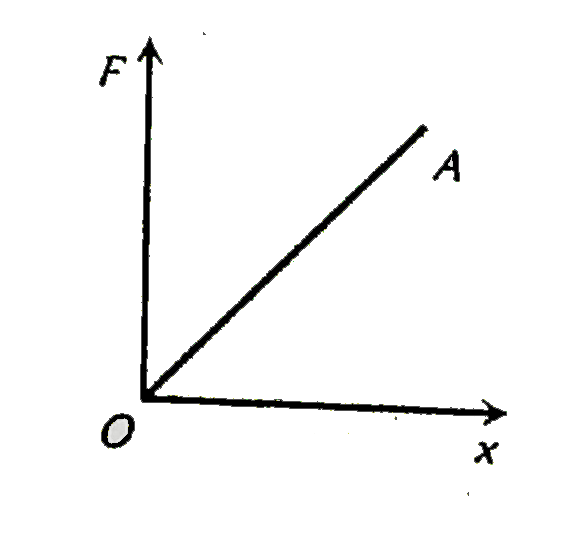
The force required to stretch a spring varies with the distance a shown in the figure. If the experiment is performed with the above spring of half length, the line OA will03:26View SolutionKinetic energy of a particle moving in a straight line varies with time `t` as `K = 4t^(2)`. The force acting on the particle
02:44View SolutionA particle is released from height `H`. At certain height from the ground its kinetic energy is twice its gravitational potential energy. Find the height and speed of particle at that height.
03:07View SolutionPower applied to a particle varices with time as `P =(3t^(2)-2t + 1)` watt, where t is in second. Find the change in its kinetic energy between time `t=2s` and `t = 4 s` .
03:42View SolutionA motor drives a body along a straight line with a constant force. The power P developed by the motor must vary with time t as
01:56View SolutionPower supplied to a mass `2 kg` varies with time as `P = (3t^(2))/(2)` watt. Here `t` is in second . If velocity of particle at `t = 0 is v = 0`, the velocity of particle at time `t = 2s` will be:
02:48View SolutionA force `F` acting on a body depends on its displacement `S` as `FpropS^(-1//3)` . The power delivered by `F` will depend on displacement as
04:14View SolutionA ball is thrown vertically upwards with a velocity of 10 `ms^(-1)`. It returns to the ground with a velocity of 9 `ms^(-1)`. If g=9.8 `ms^(-2)` , then the maximum height attained by the ball is nearly (assume air resistance to be uniform)
06:19View SolutionAn open knife of mass m is dropped from a height h on a wooden floor. If the blade penetrates up to the depth d into the wood. The average resistance offered by the wood to the knife edge is .
02:23View SolutionThe force acting on a body moving along x-axis variation of the particle particle shown in the figure. The body is in stable equilibrium at
 . 01:55View Solution
. 01:55View SolutionHow much mass is converted into energy per day in a nuclear power plant operated at `10^(7)` kW?
02:57View SolutionA block of mass M is pulled along a horizontal surface by applying a force at angle `theta` with the horizontal. The friction coefficient between the block and the surface is `mu`. If the block travels at a uniform velocity, find the work done by this applied force during a displacement d of the block.
04:05View SolutionIf `v` be the instantaneous velocity of the body dropped from the top of a tower, when it is located at height `h`, then which of the following remains constant?
01:50View SolutionA block of mass 1 kg slides down a rough inclined plane of inclination `60^(@)` starting from its top. If coefficient of kinetic is 0.5 and length of the plane d=2 m, then work done against friction is
03:59View SolutionA proton is kept at rest. A positively charged particle is released from rest at a distance `d` in its field. Consider two experiments, one ini which the charged particle is also a proton and in another, a position. In the same time `t`, the work done on the two moving charged particles is
08:03View SolutionTwo inclined frictionless tracks, one gradual and the other steep meet at A from where two stones are allowed to slide down from rest, one on each track as shown in figure. Which of the following statements is correct?
 04:16View Solution
04:16View SolutionThe potential energy function for a particle executing linear SHM is given by `V(x)= 1/2kx^2` where k is the force constant of the oscillator. For `k = 0.5 Nm^(-1)`, the graph of V(x) versus x is shown in the figure A particle of total energy E turns back when it reaches `x=pmx_m`.if V and K indicate the potential energy and kinetic energy respectively of the particle at `x= +x_m`,then which of the following is correct?
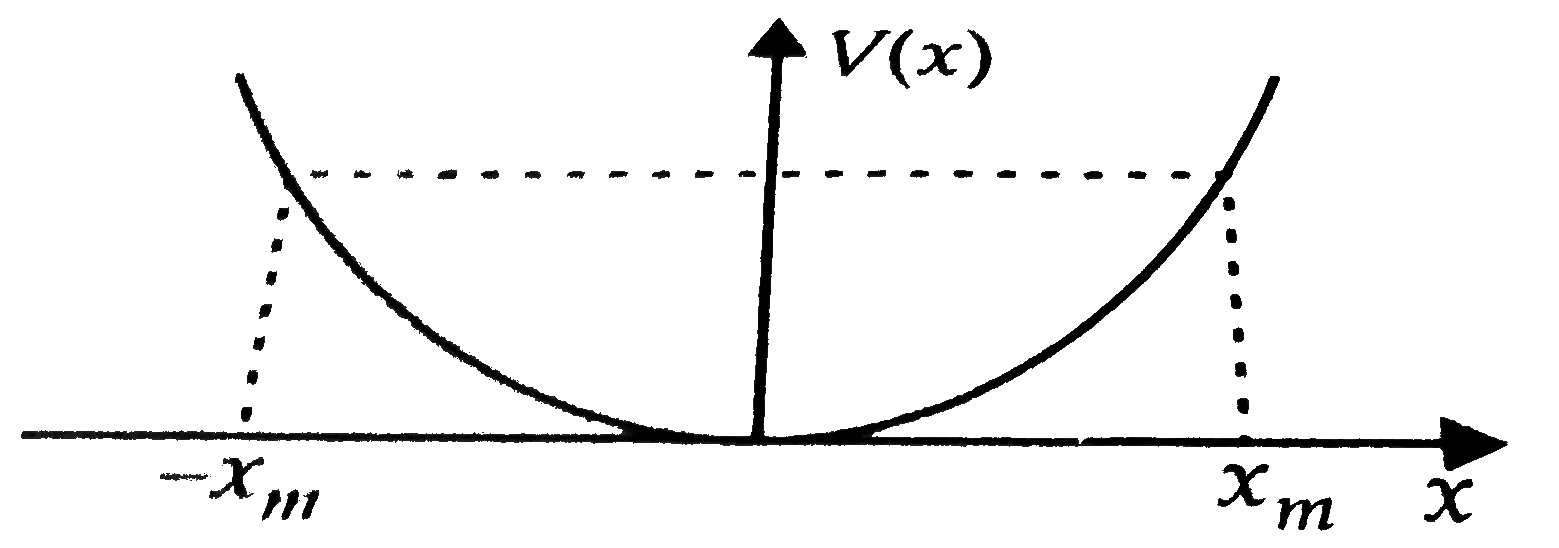 01:52View Solution
01:52View SolutionA body of mass `0.5 kg` travels in a straight line with velocity `v =a x^(3//2)` where `a = 5 m//s^(2)`. The work done by the net force during its displacement from `x = 0` to `x = 2 m` is
04:55View SolutionA raindrop falling from a height h above ground, pure ring attains a near terminal velocity when it has fallen through a height`(3/4)h`. Which of the diagrams shown in figure correctly shows the change in kinetic and potential energy of the drop during its fall up to the ground ?
03:34View SolutionIn a shotput event an athlete throws the shotput of mass `10 kg` with an initial speed of `1 ms^(-1)` at `45^@` from a height `1.5 m` above ground. Assuming air resistance to be negligible and acceleration due to gravity to be `10 ms^(-2)`, the kinetic energy of the shotput when it just reaches the ground will be
03:55View SolutionThe potential energy between two atoms in a molecule is given by `U(x)= (a)/(x^(12))-(b)/(x^(6))`, where a and b are positive constants and x is the distance between the atoms. The atom is in stable equilibrium when
03:37View SolutionIn position A kinetic energy of a particle is 60 J and potential energy is -20 J. In position B, kinetic energy is 100 J and potential energy is 40 J. Then, in moving the particle from A to B
04:27View Solution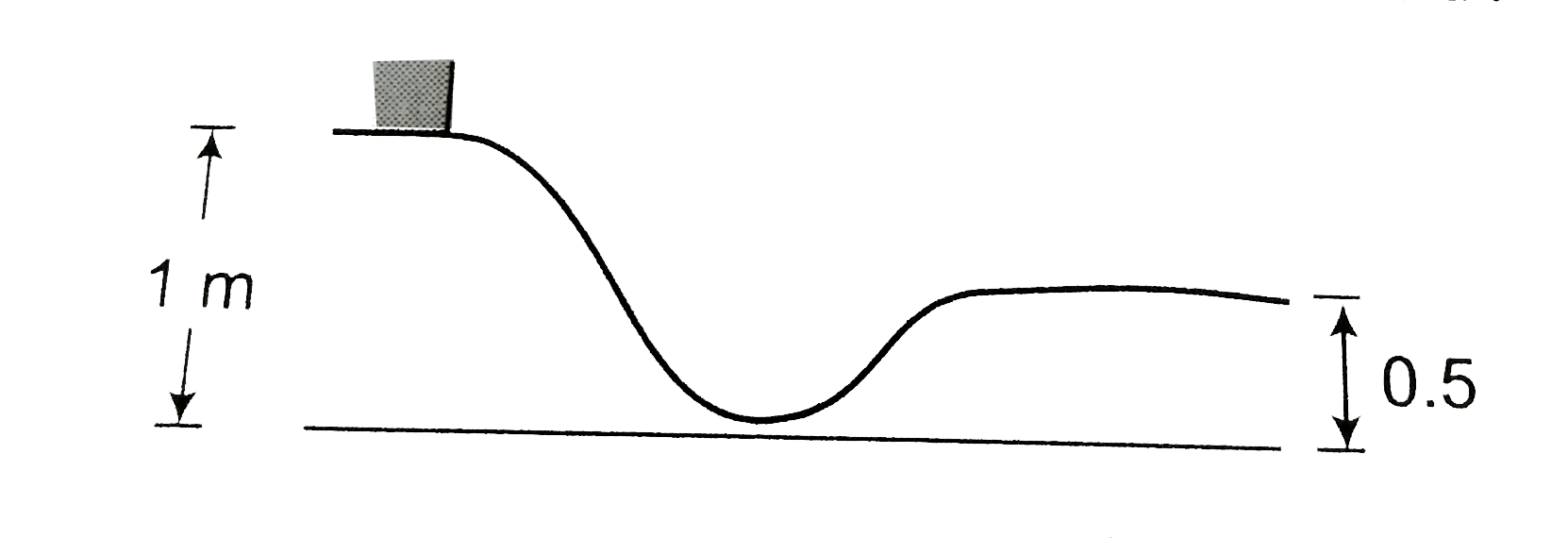
The figure shown a particle sliding on a frictionless track, which teminates in a straight horizontal section. If the particle starts slipping from the point `A`, how far away from the track will the particle hit the ground?05:44View Solution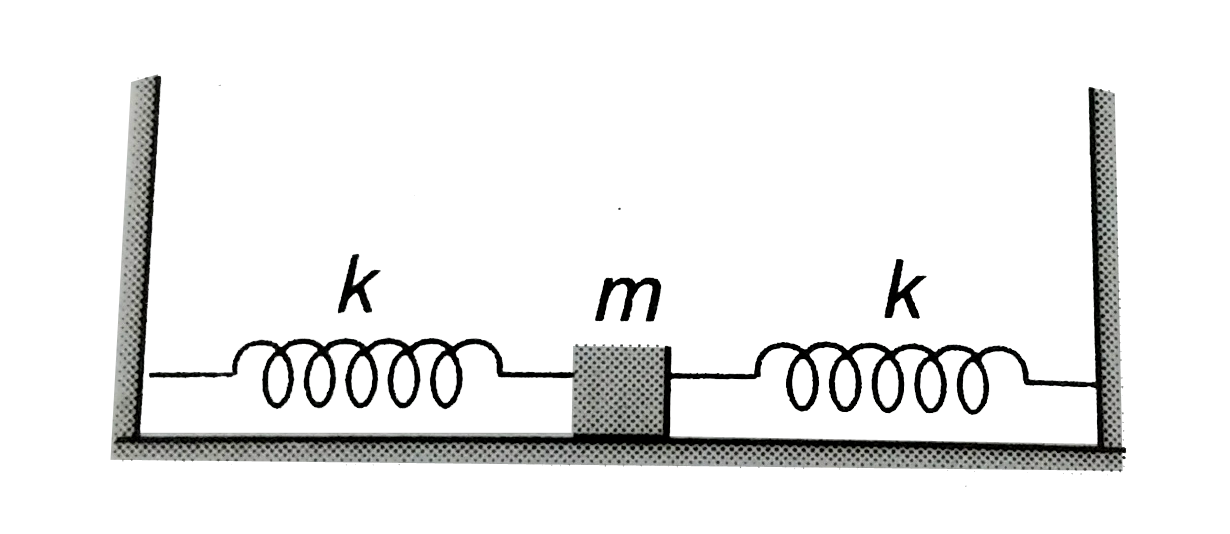
A block of mass `m` is attached to two unstretched springs of spring constant `k`, each as shown. The block is displaced towards right through a distance `x` and is released The speed of the block as it passes through the mean position will be03:26View Solution
The curved portions are smooth and horizontal surface is rough. The block is released from `P`. At what distance from A it will stop?the friction coefficient for rough flat surface is 0.2.03:40View SolutionThe system shown in the figure is released from rest. At the instant when mass M has fallen through a distance h, the velocity of m will be
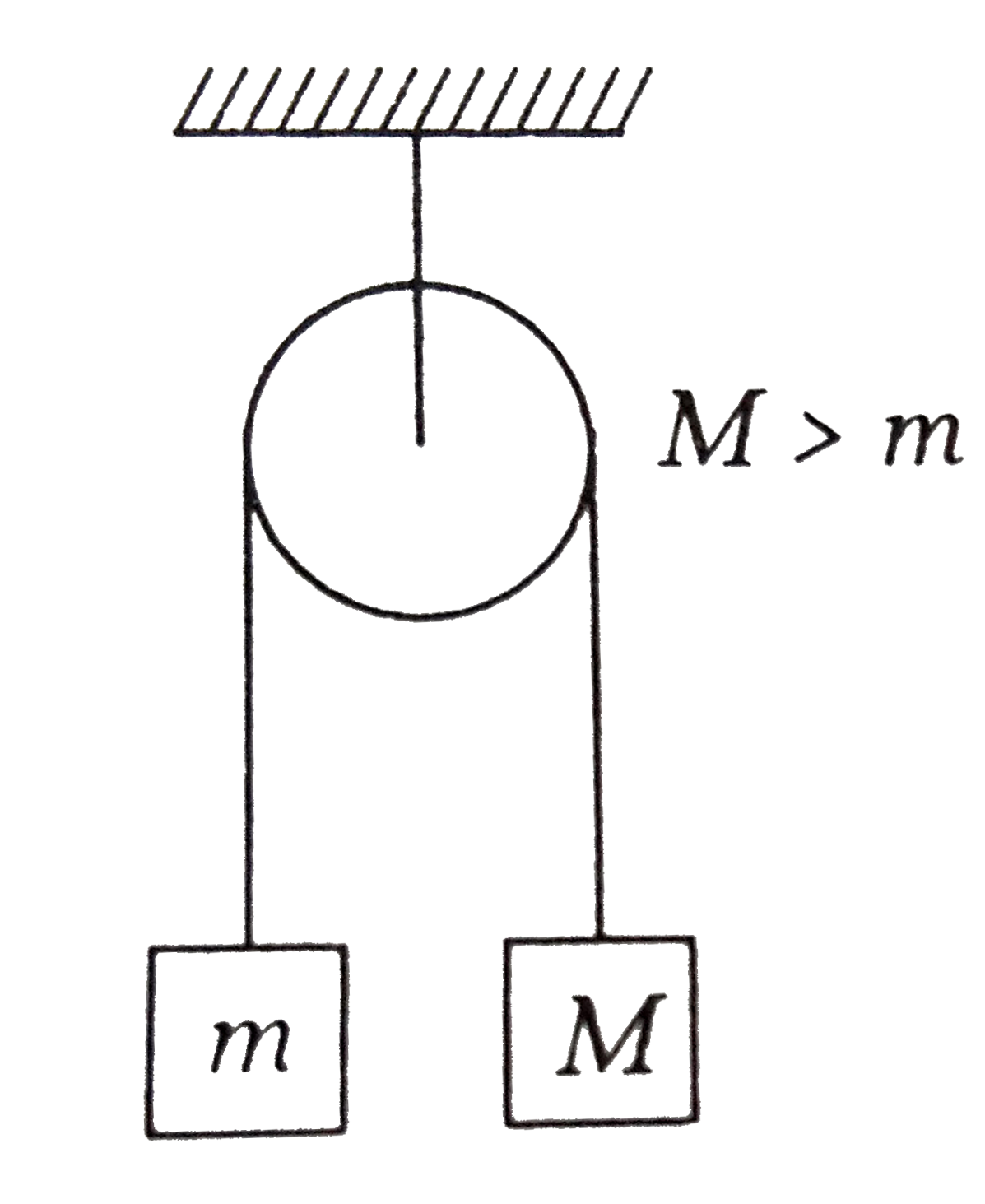 03:30View Solution
03:30View SolutionA plank of mass 10 kg and a block of mass 2 kg are placed on a horizontal plane as shown in the figure. There is no friction between plane and plank. The coefficient of friction between block and plank is 0.5 .A force of 60 N is applied on plank horizontally. In first 2 s the work done by friction on the block is
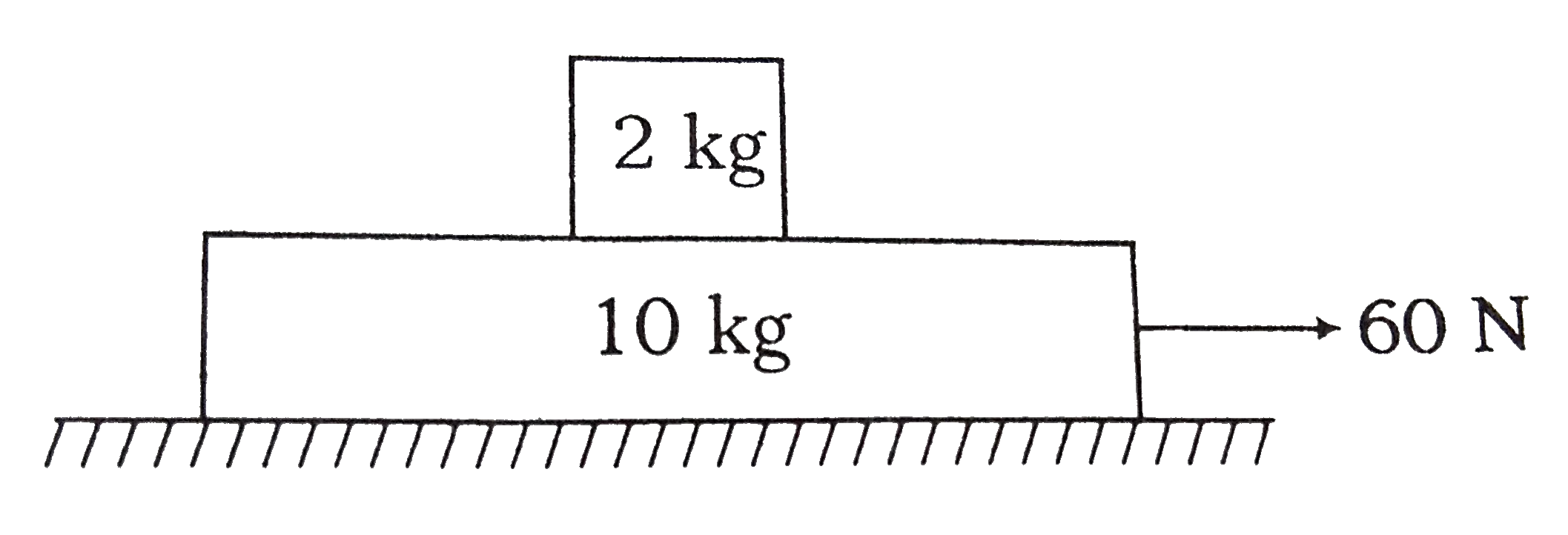 04:15View Solution
04:15View SolutionA block of mass 5 kg slides down a rough inclined surface. The angle of inclination is `45^(@)`. The coefficient of sliding friction is 0.20. When the block slides 10 cm, the work done on the block by force of friction is
03:38View SolutionA particle moves move on the rough horizontal ground with some initial velocity `V_(0)`. If `(3)/(4)` of its kinetic enegry lost due to friction in time `t_(0)`. The coefficient of friction between the particle and the ground is.
04:44View SolutionA 50 kg girl is swinging on a swing from rest. Then, the power delivered when moving with a velocity of `2ms^(-1)` upwards in a direction making an angle `60^(@)` with the vertical is
02:52View SolutionA bead can slide on a smooth circular wire frame of radius r which is fixed in a vertical plane. The bead is displaced slighty from the highest point of the wire frame. The speed of the bead subsequently as a function of the angle `theta` made by the bead with the verticle line is
03:21View SolutionA uniform chain has a mass M and length L. It is placed on a frictionless table with length `l_(0)` hanging over the edge. The chain begins to slide down. Ten, the speed v with which the end slides down from the edge is given by
03:35View SolutionA particle of mass 1 g executes an oscillatory motion on the concave surface of a spherical dish of radius 2m placed on a horizontal plane, Figure . If the motion of the particle begins from a point on the disc at a height of 1 cm. from the horizontal plane and coefficient of friction is 0.01 , find the total distance covered by the particle before coming to rest.
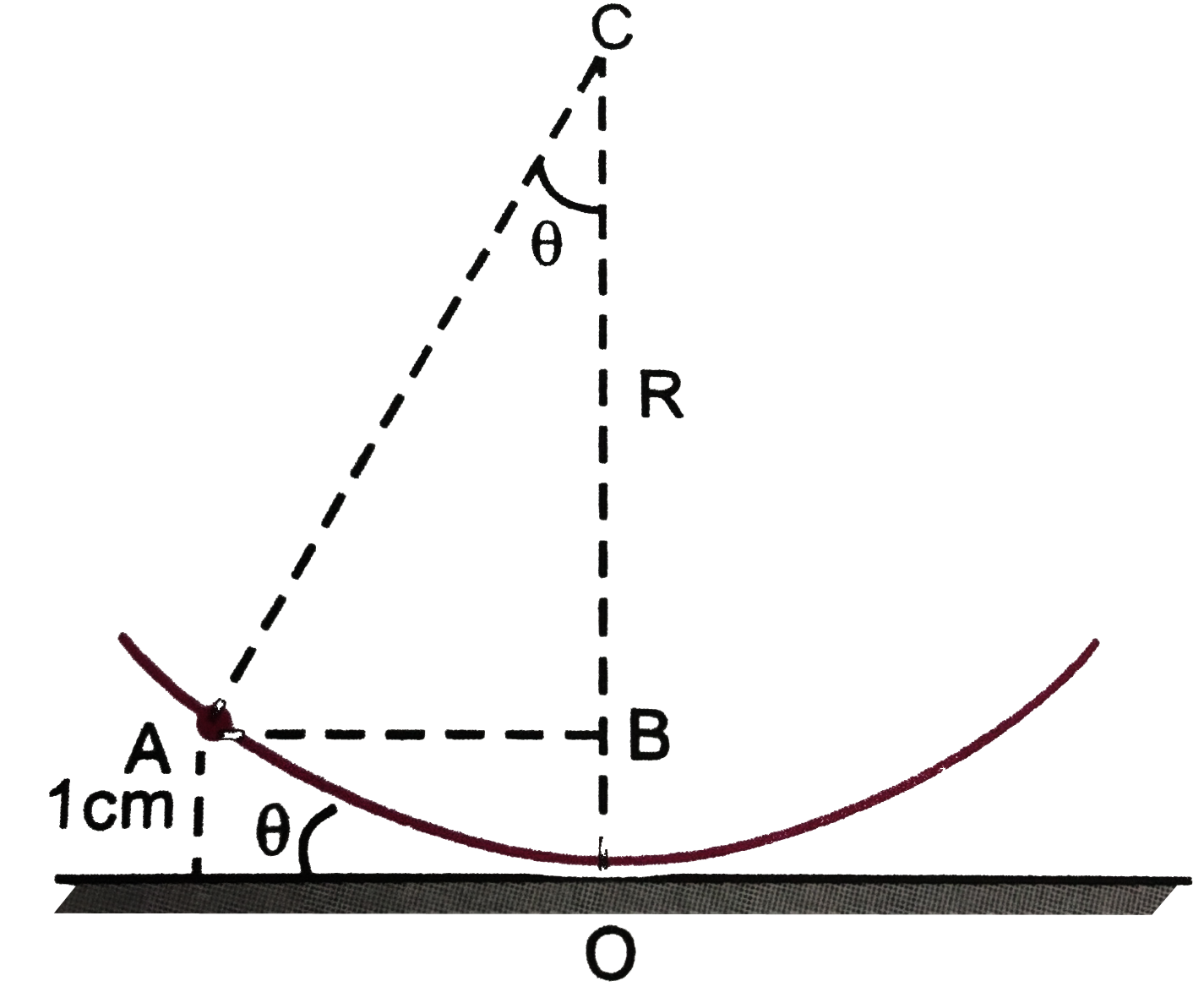 06:20View Solution
06:20View SolutionA mass-spring system oscillates such that the mass moves on a rough surface having coefficient of friction `mu`. It is compressed by a distance a from its normal length and, on being released, it moves to a distance b from its equilibrium position. The decrease in amplitude for one half-cycle (-a to b) is
04:27View SolutionA uniform flexible chain of mass m and length l hangs in equilibrium over a smooth horizontal pin of neglible diameter. One end of the chain is given a small verticle displacement so that the chain slips over the pin. The speed of chain when it leaves pin is
04:00View SolutionThe potential energy of a particle of mass 1 kg `U = 10 + (x-2)^(2)`. Here, U is in joule and x in meter. On the positive x=axis particle travels up to x=+6cm. Choose the wrong statement.
05:10View SolutionA body is moving is down an inclined plane of slope `37^@` the coefficient of friction between the body and the plane varies as `mu=0.3x`, where x is the distance traveled down the plane by the body. The body will have maximum speed. `(sin 37^@ =(3)/(5))` . a) at x = 1.16 m b) at x = 2m c) at bottom most point of the plane d) at x = 2.5 m
06:21View SolutionA force of F=0.5 N is applied on lower block as shown in figure. The work done by lower block on upper block for a displacement of 3 m of the upper block with respect to ground is (Take, g=10 `ms^(-2)`)
 03:29View Solution
03:29View SolutionA bead of mass `1/2 kg` starts from rest from A to move in a vertical place along a smooth fixed quarter ring of radius `5 m`, under the action of a constant horizontal force `f=5 N` as shown. The speed of bead as it reaches the point (B) is [Take `g=10 ms^(-2)`]
 05:12View Solution
05:12View SolutionA car of mass m is accelerating on a level smooth road under the action of a single F. The power delivered to the car is constant and equal to P. If the velocity of the car at an instant is v, then after travelling how much distance it becomes double?
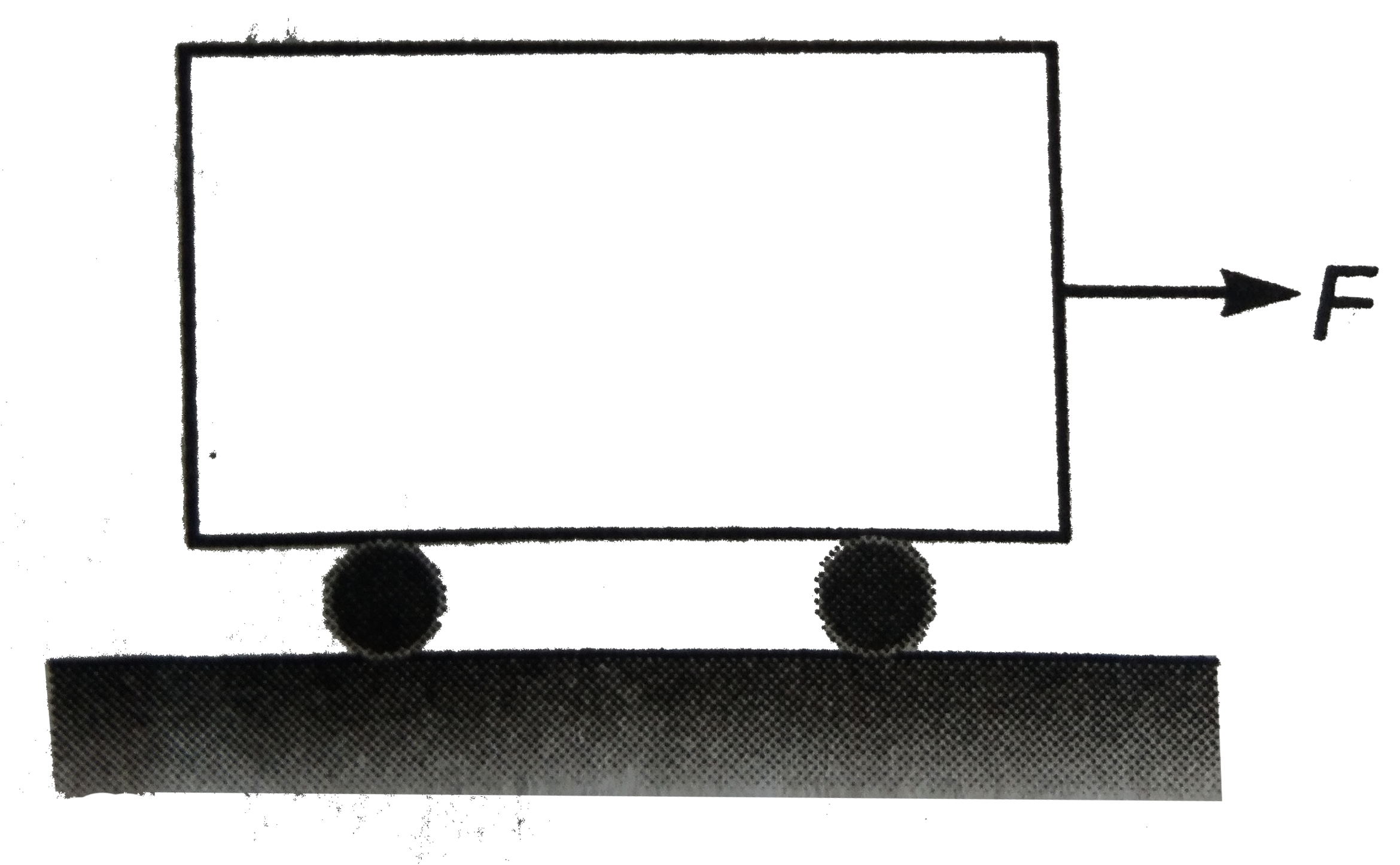 . 04:50View Solution
. 04:50View SolutionAn ideal massless spring S can be compressed 1 m by a force of 100 N in equilibrium. The same spring is placed at the bottom of a frictionless plane inclined at `30^(@)` to the horizontal. A 10 kg block M is released from rest at the top of the incline and is brought to rest momentarily after compressing the spring by 2 m. If `g = 10 m//s^(2)`, the speed of mass just before it touches the spring is `sqrt(10x) m//s`. Find value of x?
 03:23View Solution
03:23View SolutionA pendulum of mass 1 kg and length `l=1` m is released from rest at angle `theta = 60^(@)`. The power delivered by all the forces acting on the bob at angle `theta = 30^(@)` will be `(g= 10 m//s^(2))`
04:02View SolutionA small block of mass m is kept on a rough inclined surface of inclination `theta` fixed in an elevator. The elevator goes up with a uniform velocity v and te block does not slide n te wedge. The work done by the force of friction on the block in time t will be
03:10View SolutionA block A of mass M rests on a wedge B of mass 2M and inclination `theta`. There is sufficient friction between A and B so that A does not slip on B. If there is no friction between B and ground, the compression in spring is
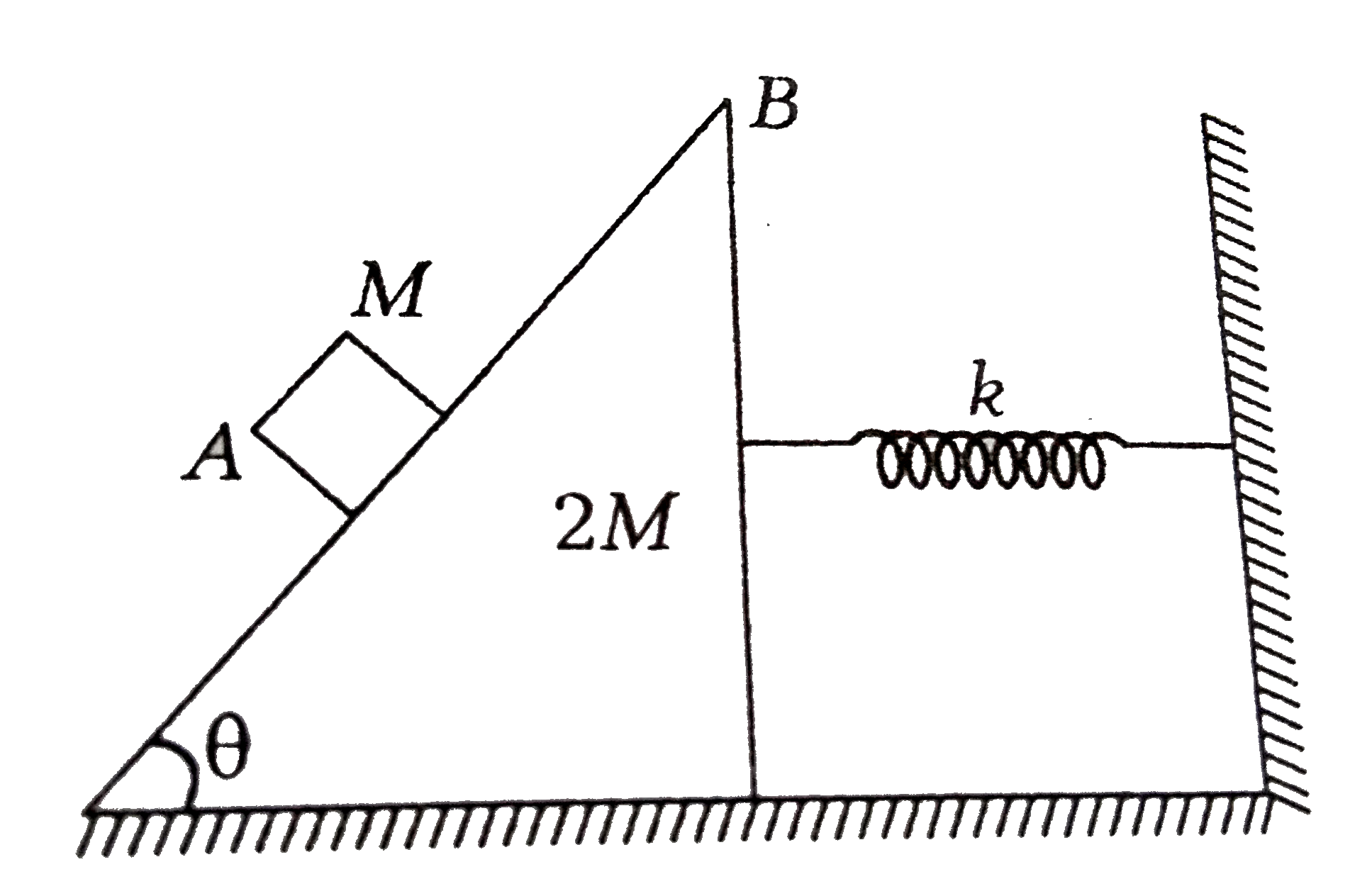 03:11View Solution
03:11View SolutionIn the figure -3.90 shown, the net work done by the tension when the bigger block of mass M touches the ground is :
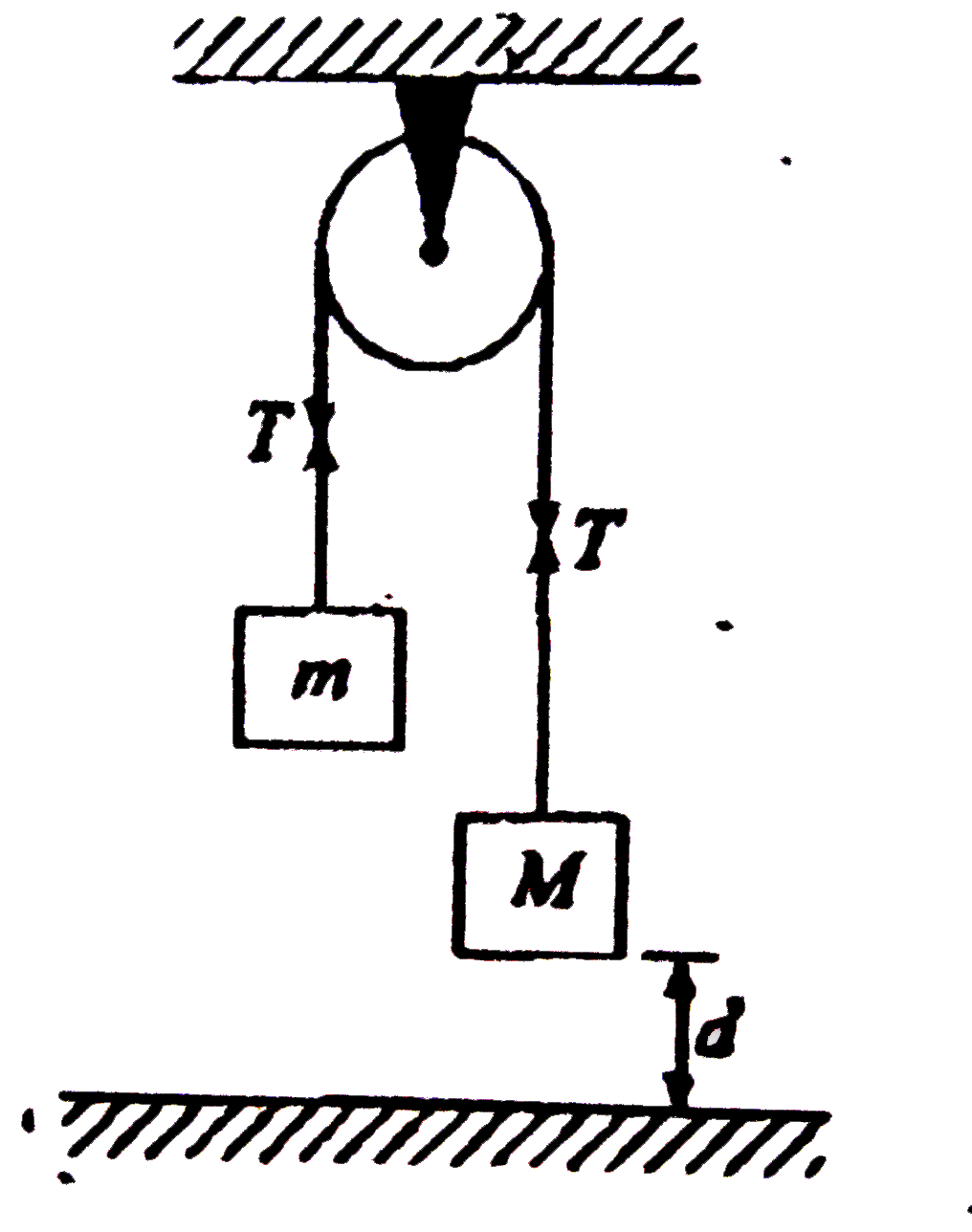 02:30View Solution
02:30View Solution
EXERCISES(TAKING IT TOGETHER) questions and complete solutions for chapter WORK, ENERGY AND POWER of DC PANDEY ENGLISH of Class 11
